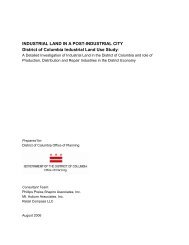An Alternative Future for the North East Mission Industrial Zone
An Alternative Future for the North East Mission Industrial Zone
An Alternative Future for the North East Mission Industrial Zone
Create successful ePaper yourself
Turn your PDF publications into a flip-book with our unique Google optimized e-Paper software.
<strong>An</strong> <strong>Alternative</strong> <strong>Future</strong> <strong>for</strong> <strong>the</strong> NEMIZ<br />
<strong>Mission</strong> Coalition <strong>for</strong> Economic Justice & Jobs<br />
III.8 IPZ Literature Review & Case Studies<br />
As new zoning is implemented, <strong>the</strong> larger supply and demand <strong>for</strong> industrial/PDR<br />
buildings in San Francisco as a whole as well as within each of <strong>the</strong><br />
five <strong>East</strong>ern Neighborhoods must be considered. If not, <strong>the</strong> City’s tax base<br />
could suffer at a time when local revenues are significantly constrained.<br />
<strong>Industrial</strong> Protective Zoning: Mostly Temporary<br />
Ra<strong>the</strong>r Than Permanent<br />
Twenty years ago, industrial protection zoning was designed to protect jobs<br />
in industrial sectors as commercial and residential uses began to compete <strong>for</strong><br />
industrial land in some communities. To retain <strong>the</strong> employment base generated<br />
by industrial uses, “cities like Chicago began to adopt new zoning that<br />
strictly limited non-industrial uses in protected corridors.” A key question<br />
is: “What is wrong with older, heavier industry moving to where <strong>the</strong> land<br />
and labor is cheaper in <strong>the</strong> region?” In San Francisco, city planners have<br />
pointed to a need to protect <strong>the</strong> core remaining industrial land because <strong>the</strong>re<br />
are some “symbiotic relations between <strong>the</strong>se industries and o<strong>the</strong>rs in <strong>the</strong> land<br />
use system” that work toge<strong>the</strong>r to make San Francisco a more competitive<br />
market and healthier economy. Many city planners still agree that “<strong>the</strong>re are<br />
some basic industries, particularly those related to construction, such as<br />
cement processing, whose survival may be essential because of <strong>the</strong>ir place in<br />
<strong>the</strong> larger web of industrial and commercial relationships in <strong>the</strong> area.” More<br />
recently, however, <strong>the</strong> same cities are reevaluating <strong>the</strong>se policies in light of<br />
<strong>the</strong> future needs and impacts of high-tech manufacturers and o<strong>the</strong>r industrial<br />
users. These cities recognize that <strong>the</strong> range of industries <strong>the</strong>y feel<br />
should continue to be protected is quite narrow. For instance, “at least some<br />
industrial protection zones should be transitional ra<strong>the</strong>r than permanent. In<br />
o<strong>the</strong>r words…it may be necessary to let <strong>the</strong> sun set on some industries in<br />
order to let it rise on o<strong>the</strong>r, more promising, ventures.”<br />
Two vacant buildings in <strong>the</strong> Bayshore that were built <strong>for</strong> hi-tech but can now<br />
be converted to serve PDR uses












